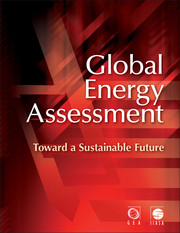Book contents
Chapter 3 - Energy and Environment
Published online by Cambridge University Press: 05 September 2012
Summary
Executive Summary
Modern energy systems have been central to the development of human societies. They have perhaps been the single most important determinant of growth of our industrial societies and our modern economy. Unfortunately, they have also been a key driver of many of the negative environmental trends observed in the world today. For example, current energy systems are the predominant source of carbon dioxide (CO2) emissions, accounting for 84% of total global CO2 emissions and 64% of global greenhouse gas (GHG) emissions related to human activities. Past trends suggest that this percentage is likely to increase in the future if our energy needs continue to be met by fossil fuels.
The impact of GHG emissions on climate is arguably the most significant environmental impact associated with our energy systems, as the effects of such emissions are felt globally. However, these effects will not necessarily be equitable. Due to the realities of global and national economics, the areas that may suffer the greatest impacts from climate change may be those that have to date contributed the least in terms of GHG emissions. Our fossil fuel-based energy systems also emit substantial quantities of other atmospheric pollutants, for example sulphur dioxide (SO2), nitrogen oxides (NOx), primary particulate matter (PM), and non-methane volatile organic compounds (NMVOCs), which degrade air quality and cause damage to health and ecosystems through processes such as acidifi cation, eutrophication, and the formation of ground-level ozone (O3) and secondary PM. Biomass-based energy systems can also have substantial impacts on land and water resources.
- Type
- Chapter
- Information
- Global Energy AssessmentToward a Sustainable Future, pp. 191 - 254Publisher: Cambridge University PressPrint publication year: 2012
References
- 2
- Cited by



